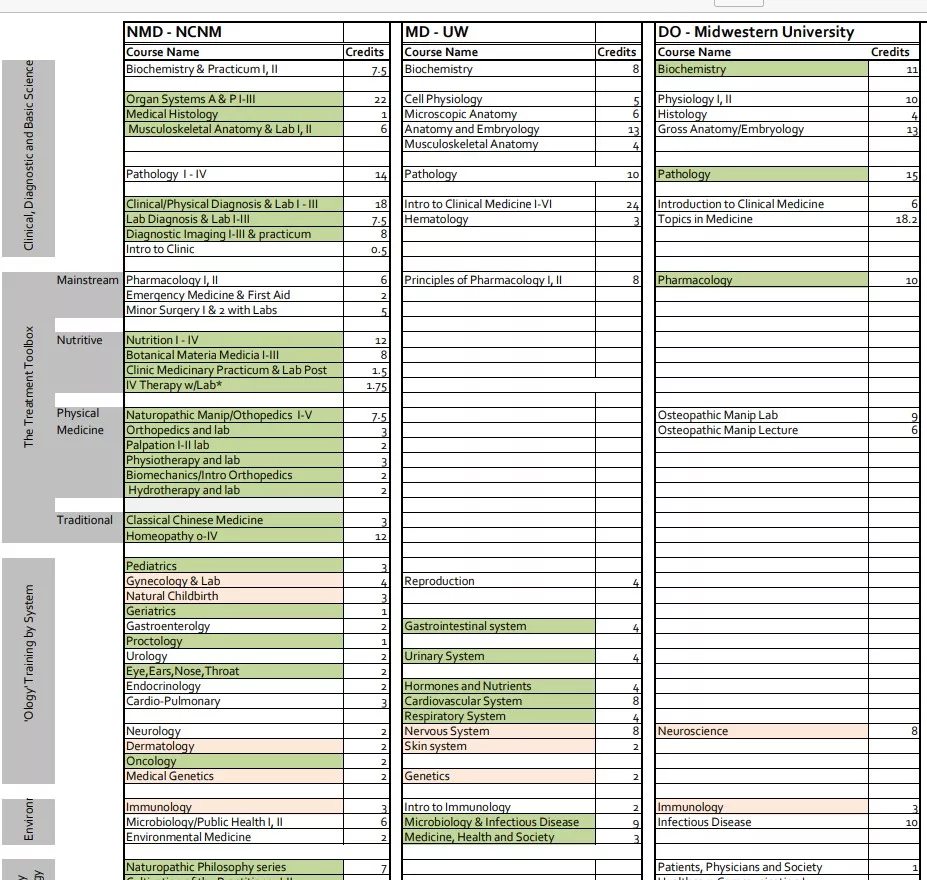What is the difference in training between Naturopathic Medical Doctors (ND or NMD), Medical Doctors (MD), Osteopaths (DO), Nurse Practitioners (NP) and Physician Assistants (PA)?
Below you can find a detailed comparison between the training of ND, MD, DO, PA and NP. You may note that there are many similarities and many differences between the training of these healthcare providers. This is to be expected, as each profession has a slightly different approach, while all still being devoted to the best patient care possible.
NDs, MDs and DOs are all strong in basic sciences and clinical diagnostics, where one degree may have slightly more training than another in any specific area. After the first 2 years, the students take their relevant Step 1 boards (NPLEX, USMLE, COMLEX, respectively). The 2-year Master’s degrees of NP and PA have completed their training at this point, trained and ready to enter clinical care with approximately half of the total training hours of their Doctorate counterparts.
In the 3rd year, MDs and DOs start to focus on applying current mainstream standard of care in their hospital clerkship rotations. At this time Naturopathic Medical Doctors partner with senior interns and enter clinic as general family medicine interns, delivering direct primary care under the direct supervision of an attending or resident doctor. Also during these last two years of training, NDs continue didactic studies on current standard of care, as well as on integrative, traditional, alternative and complimentary treatment modalities.
Thus, when an MD may be going through 12 weeks of surgery rotations, an ND may be learning orthopedic manipulations, herbal medicines and advanced nutrition principles and bringing these experiences to their clinic shift patients later that day. It is in this extensive training that includes mainstream standard of care as well as natural, progressive, nutritive and traditional modalities where the key differences are noted between how these doctorate-level programs are delivered.
Additionally, NDs are trained to apply these skills using the Philosophies of Naturopathic medicine, where the entirety of the patient is considered and where the least invasive, most natural and most efficacious treatments are selected, with the active input of the patient.
Who accredits these schools? .
There are seven schools that have accredited Naturopathic medical programs. NCNM, my alma mater, is accredited by the Council on Naturopathic Medical Education (CNME), which in turn is accredited by the US DOE. It is also accredited by Northwest Commission on Colleges and Universities, the body that accredits the University of Washington’s Medical School.
There are a couple of internet outfits that provide ‘naturopath’ diplomas. Their training does not approach that of any of the above discussed professions and should not be counted on to safely diagnose or treat a patient. Always ensure that any ND that you work with graduated from a school accredited by the CNME.
What about Residencies?
As you may know, the MD & DO residency system in the United States is publicly funded through the Direct Medical Education (DME) programs from the federal Department of Health and Human Services (DHHS), in particular through medicare. At present, ND are not fully recognized for DME inclusion.
With the advent of the ACA (Obamacare), NDs do have higher recogition, which will be further clarified as the DHHS generates the regulations for the Act. Additionally, the federal government has recognized NDs directly via in DEA regulations as well as in the Indian Health Services Act. Each of these recognitions brings NDs closer to full recognition by DHHS, thus closer to access to DME funding, and mandatory residencies.
At current, the limited number of ND residencies are privately funded, the bulk of which are teaching residencies. Many NDs create traditional apprenticeships to continue their training under established and experienced doctors.
Before, during and after his medical training, Dr Adam Sandford has done extensive research and comparisons into the similarities and differences in these programs, to ensure that his training is on par with, or exceeds, the existing standard of training for medical professionals.
Below you may find both a simple comparison of NDs, MDs and PAs, as well as a PDF which adds DOs and NPs.


Recent Comments